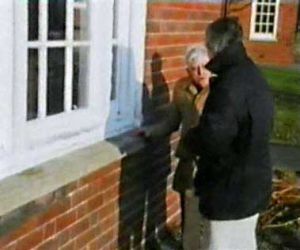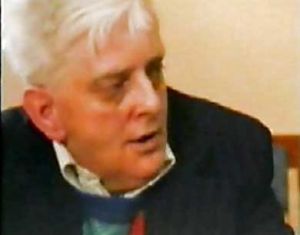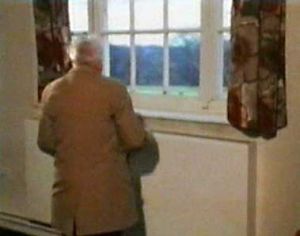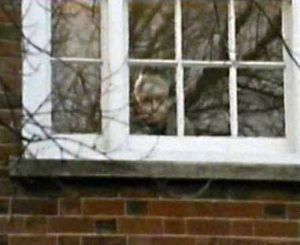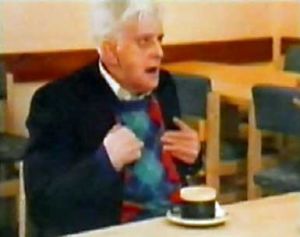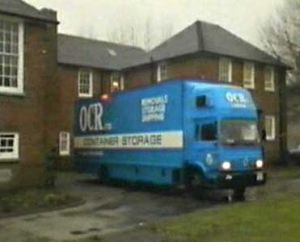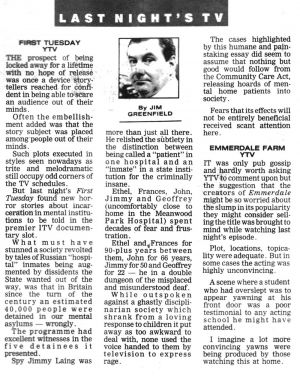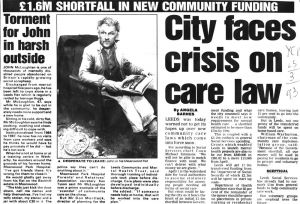Out Of Sight…
Transmission date June 2, 1993
Documentary about the introduction of the Community Care Act in April 1993 and the closure of many of Britain’s older mental hospitals. This report reveals how thousands of people, who were locked away in such institutions for long periods of their lives, were never mentally ill in the first place. They were incarcerated for being deaf or pregnant or simply unwanted, but, once committed they were automatically deemed insane, and had no way of escaping. Includes the personal testimonies of a number of victims of this cruel and outdated system.
I have had to break it down into 6 parts, Some good footage of Storthes Hall, Stanley Royd, Meanwood Park Colony, New Church Hospital, Carstairs and former service user experiences including Jimmy Laing.
In part one Geoffrey Abbott is featured, Geoffrey spent 22 years in Meanwood wrongly diagnosed as a mental defective.
He was in fact deaf and of above intelligence, it was that very intelligence that kept him sane for all those years.
Executive Officer Squires took him after his father signed the papers required to remove him to Meanwood.
He was eventually rescued by Martin Smith, Geoffrey also features in part 5.
Out of sight – out of mind – part one.
(A Clock ticks….)
John Sylvester
“I wonder why was it they never let me out, that’s all I used to think, why was I locked up for all of them years. I wanted to be a footballer or cricketer – I never got the chance.”
Frances Schofield
“When we were put away and when I got there and when I seen the nurses, I thought what am I here for, there’s nothing wrong with me. We shouldn’t have ever been in there”
Ethel Williams
“Wasn’t anything of our fault like. It was really me dad like, you know, why we got put away”
Jimmy Laing
“But what angers me and I do get angry, raging and raging and I’m thinking about the power they have to do this to you, the fact that you know it’s wrong and that there’s no redress and after all you are sick. I had been in the system for fifty years but let me tell you there are many many more like me”
1993 – our mental hospitals are closing but to turn back the clock and a shocking fact emerges – thousands of patients should never have been there.
Sister Mary Shaw, Stanley Royd Hospital
“You used to look on the ward and see how well they were coping and wonder why, what are they doing here, why have they been in all these years. It were just something that you accepted, something that happened, I don’t know why we didn’t question it, I don’t know”
Asylums like Stanley Royd in Wakefield are at the end of an era spanning two hundred years, an era when people were defined as mentally deficient and often locked away for lifetimes. Among them were many thousands who suffered no mental illness, but the system didn’t notice.
Ray Wilk, Chief Executive, Wakefield Community Health Trust.
“I suppose you can go back to the 1920s and the century before that when people were very judgemental and why people came into a hospital like Stanley Royd. The judgement was made by society, the judgement was made by families, the judgement might even have been made by legal professions. I would have thought something like 30% of our population slipped through the net, either because of a wrongful diagnosis, if such a thing existed in the early parts of the century, or simply because people wanted to see them locked away and not to have a constant reminder of bad behaviour. If 30% of the asylum population slipped through the net earlier this century then some 40,000 people were wrongly locked away.
Once they were inside they were labelled and you were insane, you were in an asylum and therefore you must be insane if you are in an asylum”
Alan Coates, Principal Social Services Officer, Stockport
“We can quite easily find endless number of people who have spent five, ten, twenty and thirty and more years living in situations that none of us would accept for ourselves. People were actually popped into hospitals for all sorts of the strangest of things, women who had illegitimate children were popped into hospital and called moral defectives, people who had limited ability, people who had physical disabilities, just pooped into hospitals and out of sight out of mind tended to be forgotten”
Tea at the deaf club in Leeds, Geoffrey Abbott, who is profoundly deaf has become a regular helper in the years since he left hospital, deafness was once a common reason for locking people up.
Martin Smith, Former Principal, Deaf Centre, Leeds.
“I would think that you would probably find in most of the major fairly secure hospitals throughout the country there are perhaps one or two examples of profoundly deaf people who had found their way in there with no good reason.”
Martin Smith, set about finding people who had been wrongly locked up.
“I went to Meanwood Park and said to the Medical Superintendent, could I please look at the deaf people that are here. The staff in the hospital brought out of the villas, in a very kind of primitive way, people who they thought were deaf, so out came this stream of people, about 24, 25 people who the hospital staff thought were deaf and Jeffrey was one of them.”
Geoffrey has never had a mental disability. His family sent him to Meanwood Park Mental Hospital in Leeds because they couldn’t cope with his deafness. He didn’t get out again for 22 years.
“My father signed a paper and put me away and put me into hospital, he just signed it. This hearing man just put me in hospital and it was my father’s fault, my father who was bad, it was wrong. Well I didn’t communicate. I didn’t talk to them, it was full of hearing people and I was by myself and there were like warders there with keys who like locked things up and I really had to be quite patient.”
Martin Smith:
“What I think is a tragedy, if you look at somebody like Jeffrey, with all his skills and his wonderful personality, which has maintained itself through those twenty two long years, you can think of so many lives that have been wasted”
John Sylvester wasted 66 years in the system; his nightmare began when he was six.
“I wasn’t very old, because me dad came from the army and my mother was alive then and she died on the 8th January 1918.”
John’s father gave his two youngest children to Nantwich workhouse, his sister Phoebe went first. John’s long journey between institution and asylum began when a receiving officer collected him in the basket of his push bike.
“It was an oblong basket, it wasn’t round, I could just fit me bottom in it he said, I said I want to turn round and see where I’m going. He said we’re not going that way, we’re going that way, you see and then we gets to the workhouse and they gave me a bath when I got there, looked after me.”
He was taken into hospital as a child of six, John spent the greater part of his three score year and ten in isolated and remote institutions and he lost complete contact with his relatives for the greater part of his life, even though he and his sister were living in the same institution at one time, contact wasn’t allowed.
“No I didn’t know much of me father, he used to drink a lot. I could smell it on him. He wanted to get rid of both of us, well he got rid of Phoebe first and then he got rid of me. I did miss home, going to see my own people and you know being there so many months I got used to it. I did about 5 years there, getting on for 5 years and on September 15th I was moved to Stoke Park, I didn’t know where I was going.”
Stoke Park Colony for Mental Defectives was 100 miles away near Bristol. It was 1926, John was not mentally ill, he’d lost his family, he was 12.
“It was in the winter, very cold and a sister come and I started to cry, I didn’t cry long. So she said, “Dry your eyes” so she said, “come on follow me” so I followed her see, she said, oo a great big dormitory it was, “that’ll be your bed.”
Out of Sight – part 2.
John Sylvester
“There was big holes in the bloody blankets, I said I dunno about the blanket, I was only 12, I said, OK , I’ll make the best of it.
In 12 years at Stoke Park, John had no visitors; he was being brought up by the staff in what was then viewed as a lunatic asylum.
“There was 129 in one ward, and some was deaf and dumb, some were blind, some couldn’t feed themselves, some couldn’t bathe themselves, you had to wipe them down or get someone to do it, staff wouldn’t do it, they were too damn lazy, staff.”
Between them Frances Schofield and Ethel Williams spent 90 years in institutions. Neither of them is mentally ill. Like many victims of the system, they stumbled into asylums via children’s homes.
Ethel Williams
“I was taken into care when I was two years old. I don’t think my mother was ill. I didn’t find out about that and I went to the Old Cottage Homes and when I got to know that they were really strict, you couldn’t even take a doll to bed to cuddle, a teddy bear, nothing. We went to bed and if we talked and if they hear us talking they would go downstairs and get a slipper and I think that was a disgrace. And it closed in 1957 and we had to all move and I went to Newchurch hospital and I got there about 5 o’ clock, I can remember going on ward 4 and I met some more children and then we met the nurses. I didn’t know that I was going in a hospital, I thought it was going to be a home, you know like with the staff, not in uniforms.”
Frances Schofield:
“Me Dad, like you know, he was a bit of a scallywag, and he used to get himself into trouble and that you know and me mother had a breakdown, you know so”.
Today Ethel and Frances share a spotless flat in Liverpool. In hospital they became lost in the system, written off as feeble minded and used as skivvies. They had no redress.
EW
“We couldn’t run away, cos we’d have got the worst end of it.”
FS
“Being in there, locked up and everything, you know, when we shouldn’t have been.”
EW
“We couldn’t even tell the social workers what was going on, cos you know with being a subnormal, staff would have said that they’re telling a pack of lies”.
For Frances, Brock Hall Hospital in the forties was the worst time.
“We were slaving all day long, used to get up 6 o clock in the morning, there used to be night nurses, they used to come in take you to the wards you worked on. You used to start work at half six till seven at night, you used to be cleaning, helping with the disabled, they used to treat the disabled people terrible an’ all. They used to hit them and that, shout at them and that. It used to upset me and I used to get myself into trouble.
Jimmy Laing was another childhood victim, who spent fifty years in the system before a psychiatrist got him out.
Jimmy Laing:
“Well today I would be called a hyperactive child, that would be it in a nutshell and in those days there were no places, so the clinic doctor, the school doctor and a psychiatrist they sent me to Baldoven institution for mental deficient boys and girls. Well actually, I was quite happy going on a train. I mean 1939 going on a train and travelling, going to Dundee and Newark was actually like going on a holiday. Arriving at Baldoven, we were met by the superintendent and they were introduced and the words I always remember because they were to haunt me for many years to come were “Come in, you’re going to be very happy here.”
Jimmy Laing was 9 years old.
“60 patients in a dormitory, 30 in some, and I think the most horrific thing even at that early time was in my “career” dare I say it, was one toothbrush for thirty boys. Well I started absconding because firstly I knew I shouldn’t be were I was, I knew that I had the qualities of being a member of society. I continued to do it and was never successful as has been proved however, the world loves a tryer and try as I did, I didn’t get to my destinations until about 50 years later.”
Jimmy Laing was trouble, he fought the system that had labelled him a mental defective, he absconded and offended. He was sent to ever more secure establishments. At sixteen, he put his fist through a window and was declared insane. He kept fighting, finally meeting his match 28 years later at Carstairs State Hospital for the criminally insane.
“Oh you had no redress, in fact patient was a word that they used it was “inmate”. Until you admitted you were ill they didn’t want to know you.”
FS
“Doors were locked all the time, nurses used to rattle their keys all the time, you couldn’t go anywhere without anybody, they used to open the door, shove you in and lock it again.
John Sylvester:
“We were never allowed out on our own. Say we wanted to go in the field or in the bathroom, staff was always first to open the door.”
FS
On the sports day, we used to walk around the field with a big fence around us “Don’t fence me in” wasn’t in it, perfect fence around you, with all the staff behind you, rattling keys.”
Britain’s mental hospitals used to be like prisons. Storthes Hall near Huddersfield once held 3000 patients, dressed like staff in uniform, the sexes strictly segregated. There was no way out, the wards were locked. It was into this former system that Frances Schofield, Jimmy Laing and countless others like them were thrown, to endure the cruel regimes of the past and treatments now confined to the museum.
Laurence Ashworth, Curator, Stanley Royd Museum.
“This is a type of strait jacket which would have been used most likely be used by patients working in the gardens, where they could with the movement they had in the arms probably wheel a wheelbarrow. The chief purpose of course, was to stop patients from escaping, from running away. Well in those days they didn’t have the tranquilising drugs that we have today and so therefore they had to use some physical method of restraint.
Out of sight – part 3.
Institutions strip away at people’s individuality and their personal value and once you strip away at people’s value, then you feel free to do all kinds of things to those people that you wouldn’t otherwise do.
FS
“ Oh aye, some of the children like, they used to rock themselves and they hit them with the chairs and they used to tie them to the radiators, hot radiators and everything
Many a time I used to be in trouble, because I used to let them loose, undo them”.
JS
“ You couldn’t say no or they’d duck your head under the water and if you said stop it, they’d do it again and you kept your mouth shut or else you’d get a mouth full of soap.”
FS
If you didn’t do what they wanted you to do, they used to put you in the padded room and you used to have to stay there with like a strait jacket on you2.
LA
“This is one of the more horrific exhibits we have here at the museum, it’s a padded cell, it was used for patients who were extremely difficult or probably very noisy, patients who sometimes asked to go in the cell because they felt themselves the tensions that were growing up in them that they were liable to do themselves harm or do somebody else some harm and so that these were replaced of course eventually by the use of tranquilising drugs.
This is an early form of ECT apparatus, Electro Convulsive therapy or electro plexia as it’s now called. The various parts here, this is a mouth gag, which prevented the patient from biting his or her tongue, this was a device for opening the jaws and preventing the mouth from closing and this is the headphone or headgear which was placed around the patients head or the patients temple and the electric current applied, which gave the electro convulsive therapy.”
JL
“There would be two nurses at each side of you with a sheet under you and a sheet over you and this was rolled in to allow you to rise when you were given the blast, 6 0 8 inches off the trolley. And it was frightening, because you were awake when you go in, don’t forget, there was no premed or anything.”
LA
“Well they were providing an electric stimulus to the brain which caused them to have a fit in effect and it was during the time that this was so that the patient’s condition was improved by the treatment.”
JL
“The methylated spirits or what have you to put on each side of your temple and I always called them the earphones and they were clamped on the other side of your head and you’re looking, and I always looked over because I may have got different voltage, but the effect to me was always the same but you saw him setting the dial and as he set the dial he gave the nod for the switch where I am and “wough” (claps) you were away. Good night and that was it” When they gave you a shock and your toes turned up towards you, they would say that was a beauty, that was a good one today”
It was the introduction of drugs that transformed the atmosphere of psychiatric hospitals. Today’s medication regimes are far more sophisticated than in the early 50s when much drug use was experimental and devastating. Jimmy Laing was forced to take one of the heavy tranquilisers.
“Sulphanol, it was called and it was widely used in Gartloch in 1950 and 51. I lost the power of my speech, I couldn’t walk, it was such a powerful drug. It was one the early tranquilisers and although I lost my speech, again if I can use the word, I was fortunate, my brain still functioned, I knew what was going on. I was aware of my surroundings, I just couldn’t speak, I couldn’t get out of bed on my own, you see and then again they reduced it and I got a speech therapist and it was back to dog and cat and mat and they used to infuriate me when in a stage whisper they used to say, “isn’t Jimmy getting on, he’s got through four words today and I used to go raging inside, furious, how dare they do this. When I got out of there and others didn’t come out too well, they sat there like this (mimics thumb in mouth) vegetated and it’s very easy to vegetate, let me hasten to add.
Treatments took their toll but it was the institutionalisation of the past that did the greatest damage.
RW
“The thing that suffered the most was this denial of individuality and the taking away of decision making of individuals and having taken away that capacity to function, we therefore said, you’re mentally ill, you cannot function, and you must remain in an institution.”
For John, for Ethel and Frances, for Geoffrey and for Jimmy time slipped down the decades and took their lives away. The system had not yet started thinking about getting them out.
